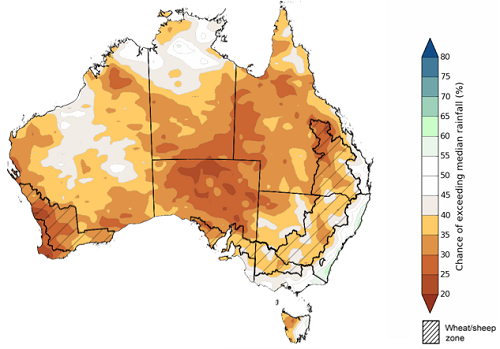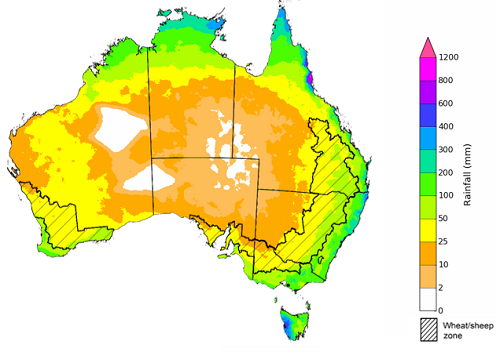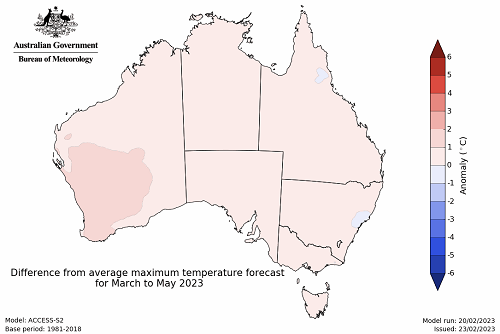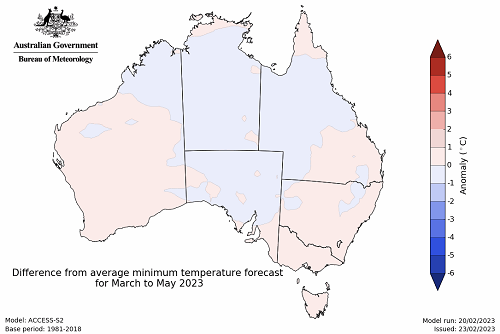Key issues
- For the week ending 22 February 2023, a tropical low active in the Gulf of Carpentaria brought heavy rainfall to surrounding areas of the tropical north of Australia. Meanwhile, a low-pressure trough brought scattered rainfall to areas of southern Queensland as well as coastal and central New South Wales.
- In cropping regions, rainfall was restricted to parts of central New South Wales and isolated areas of western and northern Queensland. Ongoing dry conditions across most summer cropping regions would have allowed for uninterrupted access to fields for crop maintenance activities and for the harvesting of early sown crops. However, in regions with below average soil moisture levels little to no rainfall is likely to negative affected the growth and yield potential of late sown summer crops.
- The La Niña event is continuing to weaken. The Madden Julian Oscillation (MJO) is currently in the Western Pacific Ocean and will likely support ongoing monsoonal activity across northern Australia, although this influence will reduce if the MJO progresses eastward and into the eastern Pacific.
- The outlook for March to May 2023 suggests there is a 75% chance of receiving between 25 and 50 millimetres across cropping regions of western New South Wales, northern and south-western Queensland, most of Victoria and Western Australia, and southern areas of South Australia.
- These rainfall totals are below average for this three-month period across most cropping regions. Given that rootzone soil moisture levels are below average to average across most summer cropping regions in New South Wales and Queensland, this below average rainfall outlook represents a significant downside production risk for late sown summer crops. This below average rainfall outlook also represents a potential downside risk for pasture growth and the early planting of winter crops across large areas of southern Australia. In contrast, drier than average conditions will assist in a largely uninterrupted harvest for early sown summer crops and led to less rain affected grain quality downgrades.
- Over the 8-days to 2 March, rainfall is expected to be restricted to northern Australia under the influence of monsoonal troughs. Little to no rainfall is expected across cropping regions. Little to no rainfall for summer cropping regions in northern New South Wales and Queensland is expected to improve access to fields for crop maintenance activities and allow for the uninterrupted harvest of early sown crops.
- Water storage levels in the Murray-Darling Basin (MDB) decreased between 15 February 2023 and 22 February 2023 by 196 gigalitres (GL). Current volume of water held in storage is 23 059 GL which represents 91 per cent of total capacity. This is 3 percent or 624 GL more than at the same time last year.
- Allocation prices in the Victorian Murray below the Barmah Choke remained steady at $15 per ML from 16 February 2023 to 23 February 2023. Prices are lower in the Murrumbidgee due to the binding of the Murrumbidgee export limit and Barmah choke trade constraint.
Climate
For the week ending 22 February 2023, a tropical low active in the Gulf of Carpentaria brought heavy rainfall to surrounding areas of the tropical north of Australia. Weekly rainfall totals exceeded 100 millimetres in these areas. Meanwhile, a low-pressure trough brought rainfall totals of between 25 and 50 millimetres to scattered areas of southern Queensland as well as coastal and central New South Wales.
In cropping regions, rainfall was restricted to parts of central New South Wales and isolated areas of western and northern Queensland. Little to no rainfall was recorded across remaining cropping regions. Ongoing dry conditions across most summer cropping regions would have allowed for uninterrupted access to fields for crop maintenance activities and for the harvesting of early sown crops. However, in regions with below average soil moisture levels little to no rainfall is likely to negative affected the growth and yield potential of late sown summer crops.
Rainfall for the week ending 22 February 2023
Note: The rainfall analyses and associated maps utilise data contained in the Bureau of Meteorology climate database, the Australian Data Archive for Meteorology (ADAM). The analyses are initially produced automatically from real-time data with limited quality control. They are intended to provide a general overview of rainfall across Australia as quickly as possible after the observations are received. For further information go to http://www.bom.gov.au/climate/rainfall/
Throughout summer the climate drivers with the largest potential impact on Australia’s climate patterns are the El Niño–Southern Oscillation (ENSO), the Southern Annular Mode (SAM) and the Madden-Julian Oscillation (MJO). These climate drivers are likely to influence the growth and development of summer crops in northern growing regions and pasture growth across northern Australia with the northern wet season.
La Niña continues in the tropical Pacific, but oceanic indicators have weakened to ENSO-neutral values. Sea surface temperature (SST) anomalies in the central equatorial Pacific continue to weaken, which is consistent with a weakening La Niña. Warmer than average temperatures persist to the south of Australia from the eastern Great Australian Bight to waters around New Zealand’s South Island, while generally weak warm anomalies persist across the west, north of the Maritime Continent and across the east of Australia. Trade winds have been stronger than average in the western half of the tropical Pacific Ocean. Elsewhere, trade wind strength was close to average. Cloudiness near the Date Line has been mostly below average, which reflects the easing La Niña event. As La Niña weakens it can continue to influence global weather and climate.
Difference from average sea surface temperature observations 6 to 12 February 2023
International climate model outlooks for the NINO 3.4 region in March 2023
Issued: 14/2/2023
All climate models surveyed by the Bureau of Meteorology anticipate central Pacific sea-surface temperatures will remain ENSO-neutral into the southern hemisphere autumn. For the period ending 19 February 2023, the 30-day SOI was +14.1. For the period ending 12 February 2023, the 90-daySOI was +15.1, both above the La Niña threshold of +7.
30-day Southern Oscillation Index (SOI) values ending 19 February 2023
As at 19 February 2023 the Madden–Julian Oscillation (MJO) is currently over the western Pacific Ocean. Most climate models suggest the MJO is likely to progress eastwards into the eastern Pacific in the coming week. While over the western Pacific, it will likely support ongoing monsoonal activity across northern Australia, although this influence will reduce if the MJO progresses eastward and into the eastern Pacific. The MJO is a pulse of cloud and rainfall that moves eastward along the equator and increases the chance of above average cloudiness and rainfall across northern Australia.
Madden–Julian Oscillation (MJO) daily index
The Southern Annular Mode (SAM) is neutral but is expected to briefly dip into negative values before remaining neutral for the coming weeks to months. During summer, a negative SAM typically suppresses rainfall over south-eastern Australia.
Southern Annular Mode (SAM) daily index
These climate outlooks are generated by ACCESS–S (Australian Community Climate Earth-System Simulator–Seasonal). ACCESS–S is the Bureau of Meteorology's dynamic (physics-based) weather and climate model used for monthly, seasonal, and longer-lead climate outlooks. For further information, go to http://www.bom.gov.au/climate/ahead/about/.
The Bureau of Meteorology’s latest rainfall outlook for March 2023 indicates wetter than average conditions are expected across parts of western and eastern Australia. The ACCESS-S climate model suggests there is a greater than 55% chance of exceeding median March rainfall totals across eastern New South Wales, as well as parts of Victoria and Tasmania, and central areas of Western Australia.
The outlook for March 2023 indicates that there is a 75% chance of rainfall totals between 25 and 200 millimeters for tropical northern Australia, eastern and south-eastern coastal areas, as well as Tasmania. For the remainder of Australia, rainfall totals are not expected to exceed 25 millimeters.
Across cropping regions there is a 75% chance of rainfall totals of between 10 and 25 millimeters across eastern New South Wales, much of Queensland and small areas of eastern Victoria and Western Australia. There is a 75% chance of less than 10 millimeters of rainfall for the remaining cropping regions.
Rainfall totals that have a 75% chance of occurring March 2023
Issued: 23/2/2023
The rainfall outlook for March to May 2023 suggests that there is a more than 60% chance of below median rainfall for much of Australia over the next three months. In contrast, for coastal New South Wales, southern Victoria, eastern Tasmania and scattered areas of Australia’s tropical north, there is no strong tendency of above or below median rainfall.
Bureau of Meteorology rainfall outlooks for March to May have greater than 50% past accuracy across large area of Australia. Outlook accuracy is greater than 65% across Queensland, the Northern Territory and Kimberley region of Western Australia. Past accuracy is low (less than 50%) for inland distracts of Western Australia, parts of north-western New South Wales, eastern and north-western South Australia.
Chance of exceeding the median rainfall March to May 2023
Issued: 23/2/2023
The outlook for March to May 2023 suggests there is a 75% chance of rainfall totals between 25 and 200 millimetres across most of Victoria and Tasmania, central and eastern New South Wales, eastern and northern Queensland, the far south of South Australia, the south-west and the Kimberley region of Western Australia, and the north of the Northern Territory. Rainfall totals in excess of 200 millimetres are forecast for the Top End of the Northern Territory, the Cape York Peninsula of Queensland and western Tasmania.
Across cropping regions, there is a 75% chance of receiving between 25 and 50 millimetres in western New South Wales, northern and south-western Queensland, most of Victoria and Western Australia, and southern areas of South Australia. There is a 75% chance of receiving between 50 and 100 millimetres across eastern New South Wales and Queensland, as well as parts of the far southeast of Western Australia.
These rainfall totals are below average for this three-month period across most cropping regions. Given that rootzone soil moisture levels are below average to average across most summer cropping regions in New South Wales and Queensland, this below average rainfall outlook represents a significant downside production risk for late sown summer crops. This below average rainfall outlook also represents a potential downside risk for pasture growth and the early planting of winter crops across large areas of southern Australia. In contrast, drier than average conditions will assist in a largely uninterrupted harvest for early sown summer crops and led to less rain affected grain quality downgrades.
Rainfall totals that have a 75% chance of occurring March to May 2023
Issued: 23/2/2023
The temperature outlook for March to May 2023 indicates that maximum temperatures across most of Australia are likely to be close to the 1990-2012 average (- 1°C to 1°C) with slightly high temperature in the southern Western Australia. Minimum temperatures are expected to be slightly below average for the Northern Territory, Queensland, South Australia, Kimberly region of Western Australia, and above average for the rest of Australia (Bureau of Meteorology ‘National Climate Outlook’, 23 February 2023).
Predicted maximum temperature anomaly for March to May 2023
Predicted minimum temperature anomaly for March to May 2023
Over the 8-days to 2 March 2023, tropical low activity persisting in northern Australia is expected to bring continuing heavy rainfall across Australia’s northern tropic. Meanwhile, low-pressure troughs in the eastern Australia are expected to bring scattered rainfall to the eastern coast of New South Wales and western Tasmania.
Rainfall totals exceeding 15 millimetres are expected across northern tropic of Australia, eastern coast of New South Wales, western Tasmania, and small parts of southern inland of Western Australia. Rainfall totals in excess of 50 millimetres are expected for Kimberly region of Western Australia, northern area of the Northern Territory, Cape York Peninsula of Queensland. Little to no rainfall is forecast for the remaining area of Australia for the next eight days.
Across Australian cropping regions, little to no rainfall is expected in the next 8 days. Little to no rainfall for summer cropping regions in New South Wales and Queensland is expected to further improve access to fields for the crop maintenance activities and allow for the harvest of early sown crops to continue. If realised, continued dry conditions in regions with low levels of soil moisture is likely to lead to further yield reductions for late sown summer crops. The forecast rainfall over much of northern Australia is likely to benefit pasture growth rates and availability.
Total forecast rainfall for the period 23 February to 2 March 2023
Note: This rainfall forecast is produced from computer models. As the model outputs are not altered by weather forecasters, it is important to check local forecasts and warnings issued by the Bureau of Meteorology.
Water
Water storages, water markets and water allocations - current week
The Tableau dashboard may not meet accessibility requirements. For information about the contents of these dashboards contact ABARES.
Commodities
Information on weekly price changes in agricultural commodities is now available at the Weekly commodity price update.












